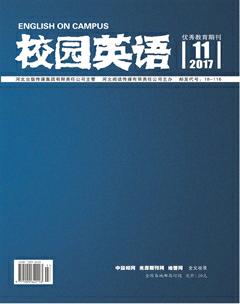Application of Transfer Theory in Second Language Acquisition and Teaching
【Abstract】In recent years, language transfer has been attached great importance in the studies of second language acquisition and teaching. Both the positive and negative transfer should be paid great attention to. The influence of mother tongue is the core aspect in the transfer theory of second language acquisition. On the one hand, if the similarities of the two languages can be fully utilized and can produce results that facilitate the second language acquisition, the influences can be referred to as positive, and the transfer can be called positive transfer. On the other hand, negative transfer exists when mother tongue has inserted interferences which may cause errors in the second language acquisition process. Restrictions may occur in the acquisition process of second language.
【Key words】application; transfer theory; teaching abstract; Second Language Acquisition
Introduction
Language transfer, a significant aspect in language acquisition theory, plays an important role in second language teaching and learning and the studies of transfer have prevailed in researches of second language acquisition and teaching.
Diversified researches have been done on the phenomena of language transfer due to the different modes of thinking. In psychology, the term “transfer” is utilized to refer to the phenomena of automatic and unconscious use of the knowledge and behaviors acquired previously in the process of dealing with new things. Later, the studies of transfer have been applied on linguistics, which has made great contributions to the studies of language acquisition and teaching, within which, mother tongue is one of the core aspects and has been attached great importance in language acquisition.
The studies of transfer theory are of great significance and have been taken seriously by scholars, researchers and teachers. This is because language transfer is a universal and inevitable phenomenon, existing in all kinds of learning and training processes. By studying the functions of transfer, learning efficiency may be improved on the basis of effective teaching.
Transfer Theory
The concept of language transfer was first proposed by Robert Lado in his book Linguistics Across Cultures, who holds that mother tongue always serves as the basis of studying a second language. The transfer of language usually demonstrates in phonetics, form, grammar, vocabulary and other aspects.
Generally speaking, language transfer refers to the influences inserted by the similarities and differences between mother tongue and the second language.
Transfer can mainly be divided into two types, including positive transfer and negative transfer. As mentioned above, transfer refers to the influences produced by the language acquired previously (usually mother tongue) on the process of second language acquisition. On the one hand, if the similarities of the two languages can be fully utilized and can produce results that facilitate the second language acquisition, the influences can be referred to as positive, and the transfer can be called positive transfer. On the other side, negative transfer exists when mother tongue has inserted interferences which may cause errors in the second language acquisition process. Restrictions may occur in the acquisition process of second language. Schachter (1974) believes that mother tongue or the knowledge acquired before, including the knowledge of mother tongue, language rules and views on the target language and other factors, may cause inferences when the learner begins to learn the second language.
Phenomena of Transfer in Second Language Acquisition
Generally speaking, the phenomena of transfer demonstrate in four aspects, including the phonetic level, the grammatical level, the vocabulary level and the cultural level.
In the phonetic level, similarities surely exist but the phonetic systems are different from each other. Take Chinese students for example, when learning English, students find it easy to pronounce certain phonemes like /i: /, /i/, /a: /, /u/, /u: /, etc., since there are similar pronunciations in Chinese phonetic system. This is the function of positive transfer. However, due to the influences of mother tongue and even the diversified accents of Chinese students, phonemes like /n/ and /l/, /w/ and /v/ are troublesome for a large number of Chinese students. This kind of interferences is called negative transfer, which means, the master of Chinese phonemes may cause negative influences on the acquisition of a new language. Therefore, the teaching of phonetics should be emphasized in the teaching process, while the positive transfer is enhanced by utilizing the similarities of pronunciation and the negative transfer is avoided by repeated practice and stress, so as to pursue a goal of standard pronunciation in rhythms, tones, intonations and stress of the foreign language.
In the grammatical level, especially in the syntactic aspect, the transfer is obvious. For most Chinese students, when express in English, the influences of mother tongue appear. On the one hand, the students may directly make a sentence without any error if the sentence structures are exactly the same. This kind of positive transfer is most common for Chinese student. On the opposite side, negative transfer exists more often. In English, multiple uses of various sentence patterns like attributive clauses, adverbial clauses, predicative clauses and so on always bother many Chinese students. In this case, comparisons should be made clear to the students, avoiding the interferences of Chinese patterns.
Conclusion
The studies of language transfer and the influences of mother tongue are key to the studies of second language acquisition and teaching, with various practical implications. Based on the analysis and application of transfer theory, this thesis has illustrated the various demonstrations and phenomena of language transfer. Countermeasures have been proposed to deal with the positive transfer and negative transfer, while several suggestions are made for the practical teaching process.
References:
[1]Odlin,T.Language Transfer:Cross Linguistic Influence in Language Learning.Shanghai:Shanghai Foreign Language Education Press,2011.
[2]Schachter,Jacquelyn.An Error in Error Analysis[J].Language Learning,1974(24).
[3]俞理明.語言遷移與二語習(xí)得:回顧、反思和研究[M].上海:上海外語教學(xué)出版社,2004.
[4]張慧芬,徐雅琴.語言遷移和第二語言教學(xué)[J].外國語,1989(4).
作者簡介: 朱燕, 女, 2004年畢業(yè)于江蘇師范大學(xué)外國語學(xué)院, 文學(xué)學(xué)士。

